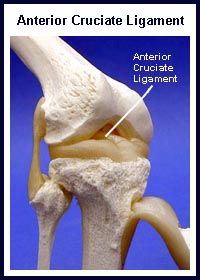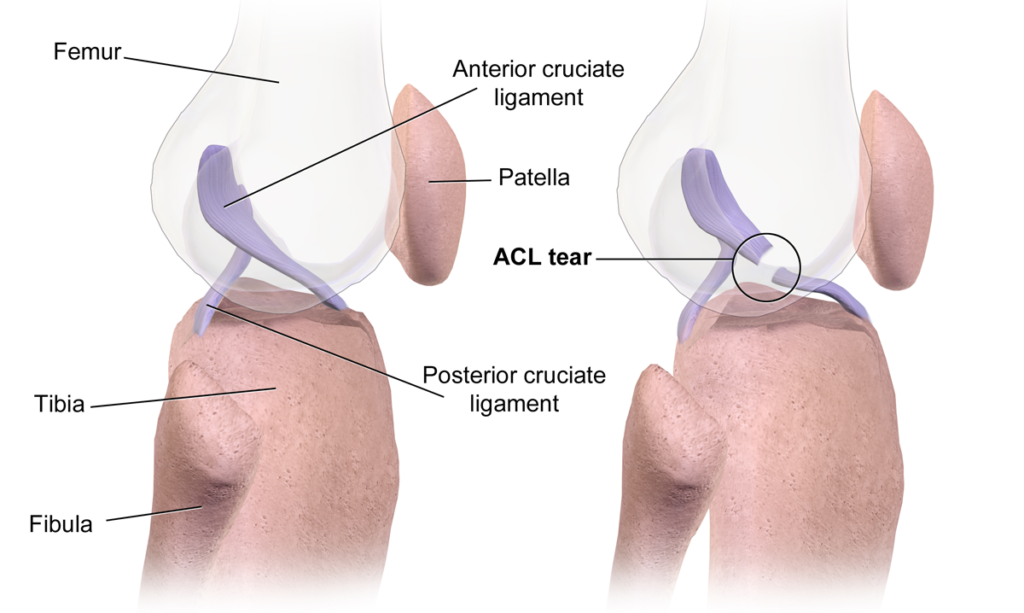In order to better understand anterior cruciate ligament (ACL) injuries, it is important to understand basic knee anatomy and the function of the ACL. Please review the knee anatomy section before reading this section.

What is an Anterior Cruciate Ligament? (ACL)?
The ACL is one of the main stabilizing ligaments of the knee. The ACL helps stabilize the knee by preventing excessive forward movement or rotation of the shin bone (tibia) on the thigh bone (femur).
What does and ACL tear feel like?
If the ACL is significantly damaged the knee can feel “unstable” or it may “give out”. Depending on the type and severity of the injury, other structures in the knee may be damaged in addition to the ACL. There may be injuries to the “shock-absorbing” cartilage menisci), the collateral ligaments (MCL or LCL), the posterior cruciate ligament (PCL) or to the bones of the knee. The degree of injury to the ACL may vary. In some cases, the ACL may only be partially torn or in more serious cases the ACL may be completely torn. Unfortunately, the ACL does not have the ability to completely heal once it is injured.

BruceBlaus, CC BY-SA 4.0 https://creativecommons.org/licenses/by-sa/4.0, via Wikimedia Commons
What can cause an ACL tear?
The ACL may be injured in a number of ways but the most common mechanisms described are a twisting injury or a sideways blow to the knee. In most cases the knee will be painful, swollen, and/or feel unstable. If the ACL is the only structure damaged the initial injury may go unnoticed until the knee is subjected to twisting or rotational forces and the knee “gives out”, “gives way”, or “collapses”.
How do you know if you have torn your ACL?
Examination techniques that detect looseness and rotational instability in the knee are effective in detecting ACL tears. X-rays are often done at the time of the injury to make sure that the bones of the knee are not broken. A special machine called an arthrometer or other tests such as Magnetic Resonance Images (MRI) are occasionally used to help diagnose ACL tears in difficult cases.
There are orthopedic tests that can help diagnose a torn ACL. They include:
How do you treat an ACL tear?
The treatment of ACL injuries depends on the severity of the injury and other associated injuries. Each treatment plan should be individualized. Initially protection (by use of crutches and/or a rehabilitation brace), rest, ice, compression and elevation (PRICE) of the injured knee will help reduce pain and/or swelling.
After an ACL injury, the long-term goal is to return the individual back to their previous level of activity. Achieving this goal will depend on the function and stability of the knee. A general knee rehabilitation program that includes strengthening exercises, flexibility exercises, aerobic conditioning, technique refinement and proprioceptive (biofeedback) retraining is the most important factor in improving knee function and stability. Stability may be improved by an ACL knee brace and/or surgery to reconstruct the ACL.
Even with the most ideal treatment, the knee may never be as “normal” as the uninjured knee and modification of activity may be required. Furthermore, some research has identified that individuals who have repetitive episodes of giving way in their knee are at greater risk for further knee injuries and premature “wear and tear” arthritis (osteoarthritis) of the knee joint. However, doctors and physiotherapists trained in treating ACL injuries can outline an individualized treatment plan which will maximize the long-term function and stability of the knee.
To read more about ACL braces click here. Please visit the links section for additional information on ACL injuries. Links have been provided to other websites as well as online medical journals. Other knee injury topics can also be accessed.
